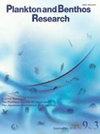Giant spoon worms pumped out of their deep burrows: First collection of the main bodies of Ikeda taenioides (Annelida: Thalassematidae: Bonelliinae) in 88 years
IF 0.6
4区 生物学
Q4 MARINE & FRESHWATER BIOLOGY
引用次数: 0
Abstract
: Ikeda taenioides (Ikeda, 1904) (Annelida: Thalassematidae: Bonelliinae) is the world ʼ s longest spoon worm species, which possesses an extremely long tape-like proboscis with a striped color pattern and a large brownish red trunk. This species is endemic to the Japanese Islands and inhabits a deep vertical burrow in intertidal and subtidal sand flats. Their proboscis, which extends from its small burrow opening, has been frequently observed around Japanese coasts. However, sampling of the main body (i.e., trunk) has been extremely rare because it always stays within a deep part of the burrow. Here, we report the success of the sampling of two specimens of I. taenioides with trunks in two different localities of the Seto Inland Sea (i.e., Ohmishima and Hachi), Japan, in 2019 and 2020 using a yabby pump. This is the first sampling of the trunk of I. taenioides in 88 years after its last collection in Onomichi Bay in 1931. We described the trunk color and morphological characteristics of the two specimens, including the internal anatomy. The trunks of the two specimens showed different colors, that is, pale brown (Ohmishima) and deep brownish red (Hachi). However, they were not distinguished to the species level by the comparison of partial COI sequences, suggesting that I. taenioides has an intraspecific variation in trunk color. Despite the difference in the sampling seasons (Ohmishima: June, Hachi: February), both specimens included numerous ripe eggs. According to previous studies, those collected in November and December also included numerous ripe eggs. Taken together, I. taenioides may be reproductive throughout the year or have multiple reproductive seasons per year.巨型勺虫从它们的深洞中被泵出:88年来首次收集到池田带虫的主体
池田绦虫(Ikeda, 1904)是世界上最长的匙形蠕虫,其长有带条纹的长鼻和大的棕红色躯干。这个物种是日本群岛特有的,栖息在潮间带和潮下沙滩上的一个深的垂直洞穴里。在日本海岸附近经常可以观察到它们的长鼻,从它的小洞口伸出来。然而,对主体(即树干)的采样非常罕见,因为它总是呆在洞穴的深处。在这里,我们报告了2019年和2020年在日本濑户内海的两个不同地点(即大岛和八市)使用yabby泵成功取样两种带躯干的带鼻伊蚊标本。这是1931年在尾道湾最后一次采集后,88年来的第一次取样。我们描述了两个标本的树干颜色和形态特征,包括内部解剖。两种标本的树干呈现出不同的颜色,即浅棕色(大岛)和深棕红色(八)。但是,在种水平上,不能通过部分COI序列的比较来区分它们,这表明taenioides在树干颜色上存在种内变异。尽管取样季节不同(大岛:6月,八公:2月),但两种标本都含有大量成熟的卵。根据之前的研究,在11月和12月收集的鸡蛋中也有许多成熟的鸡蛋。综上所述,带纹蠓可能全年都在繁殖,或者一年有多个繁殖季节。
本文章由计算机程序翻译,如有差异,请以英文原文为准。
求助全文
约1分钟内获得全文
求助全文
来源期刊

Plankton & Benthos Research
Agricultural and Biological Sciences-Aquatic Science
CiteScore
1.30
自引率
0.00%
发文量
32
期刊介绍:
Plankton and Benthos Research is a peer-reviewed journal publishing quarterly original papers, reviews and notes dealing with any aspect of the biology and ecology of planktonic and benthic organisms and their interactions with the environment in any aquatic system, and is open to all scientists around the world. Submission of a paper is held to imply that it represents an original contribution not previously published and that it is not being considered elsewhere.
 求助内容:
求助内容: 应助结果提醒方式:
应助结果提醒方式:


